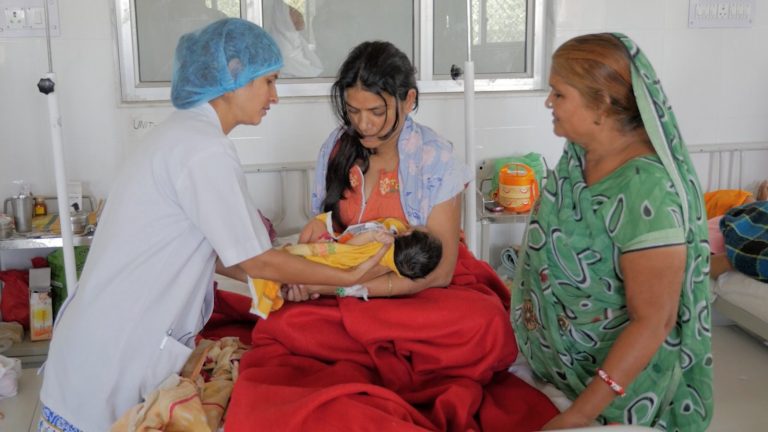Special needs of small and sick newborns
Approximately 2.5 million newborns do not reach their second month of life;[i] 98 percent of those deaths occur in low- and middle-income countries (LMICs).[ii] At greatest risk of death are small and sick newborns (SSNs), defined as those born preterm (< 37 weeks gestation), small for gestational age, low birth weight (< 2,500 g birth weight), suffering from an illness from a birth complication, or requiring hospitalization. Transforming the quality of care for SSNs has become a global priority with recently launched global policy resources (Survive and Thrive: Transforming Care for Every Small and Sick Newborn, 2019; Standards for Improving the Quality of Care for Small and Sick Newborns in Health Facilities, 2020) and is considered a highly cost-effective target population for investing resources.
Although breastfeeding and the provision of human milk are included as evidence-based, high-impact interventions for the newborn, ensuring human milk for the special SSNs population presents unique challenges, requiring specialized response. Unlike healthy, full-term infants, the majority of SSNs are unable to feed directly at the breast immediately after birth due to underdeveloped oral motor skills, mother-infant separation, or birth complications. Moreover, lactogenesis may be delayed or impaired due to preterm birth, stress, or a lack of stimulation typically triggered with breastfeeding. As a result, these high-risk neonates are predisposed to inadequate intake of breast milk, and mothers are susceptible to having an inadequate milk supply if not fully supported.
As momentum increases globally to improve the quality of care for the SSN, so should enhanced focus to improve access to human milk through specialized lactation support for their mothers. Although the updated 2018 Baby Friendly Hospital Initiative (BFHI) guidelines acknowledges SSNs are high risk and require specialized care, clear guidance on how to operationalize specialized lactation support is needed to inform national and facility-level plans to achieve the BFHI target that “80 percent of infants (preterm and term) receive only breast milk (either from their own mother or from a human milk bank) while in the hospital.”[iii]
Exploration of skilled breastfeeding support for SSNs
Through a comprehensive literature review, we sought to answer how skilled breastfeeding support is defined, what lactation support is currently provided to mothers of SSNs, and what guidelines (global, national, hospital) exist specifically to promote the provision of human milk for SSNs. We identified three emerging themes from the literature: 1) inconsistencies in defining skilled breastfeeding support for SSN; 2) very few evidence-based trainings for neonatal intensive care unit (NICU) staff on lactation support for SSNs; 3) wide ranges in the extent and quality of lactation support provided to mothers with newborns in the NICU, dependent on hospital leadership.
Core requirements for supporting maternal lactation for SSNs
Published literature identified successful models, primarily in high-income settings (Box 1), although programs in LMICs do exist. Consistent elements define these programs’ success: 1) NICU staff are trained on the benefits of providing human milk to a SSN, as well as how to support lactating mothers in the NICU; 2) NICU staff provide consistent information and frequent education to mothers on feeding their infant and the benefits of human milk; 3) NICU staff assist mothers with fitting and using a breast pump, storing breast milk, and developing a pumping schedule so the mother can establish her milk supply within the first two weeks; 4) NICU staff facilitate and encourage rooming-in, skin to skin contact , and non-nutritive sucking at the breast; 5) each hospital has their own set of educational materials and tools to track milk production.
A call to action to prioritize provision of skilled breastfeeding support for SSNs
In line with the 2020 World Prematurity Day Theme, “Together for babies born too soon—Caring for the future” with focus on supporting families and health care professionals and strengthening health care systems, we implore the field for recognition that there remains a critical gap in supporting early maternal lactation to ensure feeding of mother’s own milk for the SSNs. We call upon global health policy and technical leaders across both newborn and nutrition fields to support the following actions:

[i] United Nations Children’s Fund (UNICEF), United Nations Inter-agency Group for Child Mortality Estimation. Levels & Trends in Child Mortality: Report 2018. New York: UNICEF; 2018. https://www.unicef.org/publications/index_103264.html.
[ii] World Health Organization (WHO). Survive and Thrive: Transforming Care for Every Small and Sick Newborn. Geneva: WHO; 2019. https://www.who.int/maternal_child_adolescent/documents/care-small-sick-newborns-survive-thrive/en/.
[iii] World Health Organization (WHO), United Nations Children Fund (UNICEF). Protecting, Promoting and Supporting Breastfeeding in Facilities Providing Maternity and Newborn Services: Implementing the Revised Baby-friendly Hospital Initiative 2018. Geneva: WHO and UNICEF; 2018. https://www.who.int/nutrition/publications/infantfeeding/bfhi-implementation/en/.
